
If a piece of metal is heated to temperature $\theta$ and then allowed to cool in a room which is at temperature, the graph between the temperature ${{\theta }_{0}}$, the graph between the temperature of the metal and time t will be closest to :
(A)
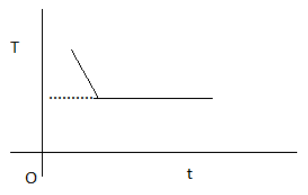
(B)
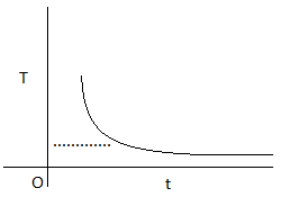
(C )
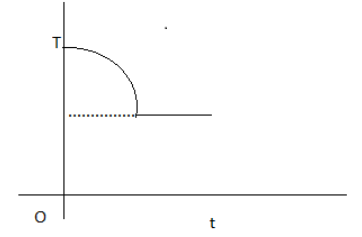
(D)
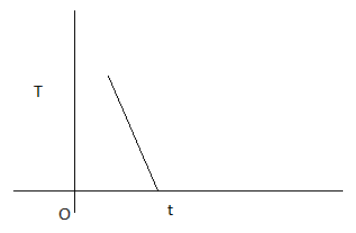




Answer
570.6k+ views
Hint: Apply Newton’s law of cooling. According to Newton’s law of cooling states that the rate of heat loss of a body is directly proportional to the difference in the temperatures between the body and its surroundings. By applying this concept and doing integration by parts we will get the solution and from that solution we can find the type of graph used to plot them.
Formula used:
$\dfrac{dT}{dt}=k({{T}_{2}}-{{T}_{1}})$
Complete answer:
$\dfrac{dT}{dt}=k({{T}_{2}}-{{T}_{1}})$
Rearranging them we get,
$\dfrac{dT}{{{T}_{2}}-{{T}_{1}}}=kdt$
Integrating on both sides we get,
$\log ({{T}_{2}}-{{T}_{1}})=-kt$
$\Rightarrow$ ${{T}_{2}}-{{T}_{1}}={{e}^{-kt}}$
$\Rightarrow$ ${{T}_{2}}={{T}_{1}}+{{e}^{-kt}}$
According to Newton’s law of cooling, the temperature goes on decreasing with time exponentially. Here we can see that temperature is exponentially decreasing. Then the graph is,
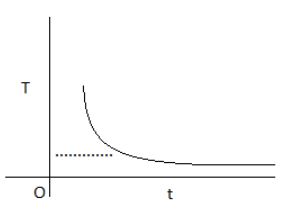
Therefore option(B) is correct.
Additional information:
According to Newton’s law of cooling the rate of heat loss of a body is directly proportional to the difference in temperature between the body and its surroundings. Newton’s law of cooling holds only for very small temperature differences. And the temperature goes on decreasing with the time. The temperature difference is very small and the nature of the heat transfer mechanism is the same.
Note:
Newton’s law of cooling holds only for very small temperature differences. And the temperature goes on decreasing with the time. The temperature difference is very small and the nature of the heat transfer mechanism is the same. Newton’s law of cooling is followed for force pumped fluid cooling, where the properties of fluid do not vary strongly with temperature. Convection cooling is usually said to be governed by Newton’s law of cooling.
Formula used:
$\dfrac{dT}{dt}=k({{T}_{2}}-{{T}_{1}})$
Complete answer:
$\dfrac{dT}{dt}=k({{T}_{2}}-{{T}_{1}})$
Rearranging them we get,
$\dfrac{dT}{{{T}_{2}}-{{T}_{1}}}=kdt$
Integrating on both sides we get,
$\log ({{T}_{2}}-{{T}_{1}})=-kt$
$\Rightarrow$ ${{T}_{2}}-{{T}_{1}}={{e}^{-kt}}$
$\Rightarrow$ ${{T}_{2}}={{T}_{1}}+{{e}^{-kt}}$
According to Newton’s law of cooling, the temperature goes on decreasing with time exponentially. Here we can see that temperature is exponentially decreasing. Then the graph is,

Therefore option(B) is correct.
Additional information:
According to Newton’s law of cooling the rate of heat loss of a body is directly proportional to the difference in temperature between the body and its surroundings. Newton’s law of cooling holds only for very small temperature differences. And the temperature goes on decreasing with the time. The temperature difference is very small and the nature of the heat transfer mechanism is the same.
Note:
Newton’s law of cooling holds only for very small temperature differences. And the temperature goes on decreasing with the time. The temperature difference is very small and the nature of the heat transfer mechanism is the same. Newton’s law of cooling is followed for force pumped fluid cooling, where the properties of fluid do not vary strongly with temperature. Convection cooling is usually said to be governed by Newton’s law of cooling.
Recently Updated Pages
Master Class 11 Economics: Engaging Questions & Answers for Success

Master Class 11 English: Engaging Questions & Answers for Success

Master Class 11 Social Science: Engaging Questions & Answers for Success

Master Class 11 Biology: Engaging Questions & Answers for Success

Class 11 Question and Answer - Your Ultimate Solutions Guide

Master Class 11 Business Studies: Engaging Questions & Answers for Success

Trending doubts
10 examples of friction in our daily life

One Metric ton is equal to kg A 10000 B 1000 C 100 class 11 physics CBSE

Difference Between Prokaryotic Cells and Eukaryotic Cells

1 Quintal is equal to a 110 kg b 10 kg c 100kg d 1000 class 11 physics CBSE

Explain zero factorial class 11 maths CBSE

What is a periderm How does periderm formation take class 11 biology CBSE




